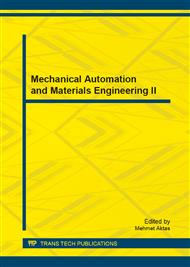p.16
p.22
p.26
p.32
p.36
p.41
p.45
p.49
p.57
Self-Healing Effect Caused by Accelerated Carbonation of Thermally Damaged Cement Mortar: Changes in Microstructural and Macroscopic Properties
Abstract:
The objective of this work was to examine the influence of accelerated carbonation on the microstructural and macroscopic properties of thermally damage cement mortar. A normalised CEM II mortar was treated at 500°C then submitted to carbonation at 20°C, 65% relative humidity and 20% of CO2 concentration. The pores size distributions were determined from nitrogen adsorption. We also followed changes in electrical resistivity and ultrasonic velocity. The results showed that losses of macroscopic properties caused by cracks appeared at high temperature were restored due to carbonation. This highlighted the self-healing effect by accelerated carbonation which allowed the thermally damaged mortar to recover its initial properties.
Info:
Periodical:
Pages:
36-40
Citation:
Online since:
June 2014
Authors:
Price:
Сopyright:
© 2014 Trans Tech Publications Ltd. All Rights Reserved
Share:
Citation:


